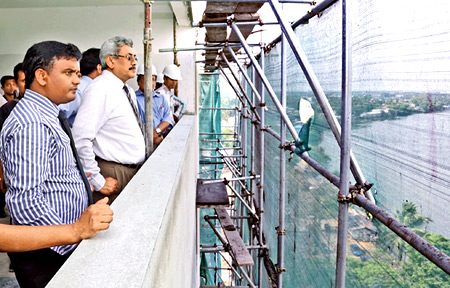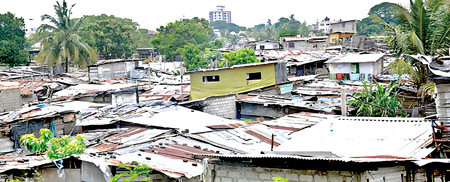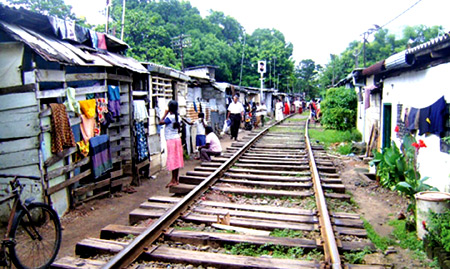|
Half of Colombo's population live in unsafe and
unhealthy environments:
Shanty dwellers to own houses
By Dhaneshi Yatawara
|

The new housing units in Dematagoda |
The Dematagoda line of shanties is a view that a traveller on the
main line of the Sri Lankan railway would never miss. The unhygienic
conditions, the unbelievable stench that emanates after the rains are
part of life of those who among these temporary habitats. An assessment
survey done three years ago on these under served communities by the
Urban Development Authority(UDA) (in 2011) showed that the total number
of such settlements counted up to 1,499 consisting of 68,762 houses. The
most recent t survey done earlier to the 2011 was a survey done in 2001
by a Non Governmental Organisation on the same under-served communities
which revealed that during this ten- year period housing units have
increased by a staggering 8,000.
According to the UDA the number of households to date in these
communities is more than 68,000 with a population of over 300,000
people. The land extent that these people live in is 900 acres. "Which
means currently, over half of the residential population in the Colombo
City is living in extreme low housing conditions occupying only 10% of
the total Colombo area," said E.A.C. Priyashantha Head of the Project
Planning Unit, Urban Regeneration program of the UDA.
Yet these people comprise almost all the labour force that make the
Colombo city function. "Many of these people work in the harbour,
Railway Department and Municipal Council forming their entire labour
force. They are playing a pivotal role in the proper functioning of the
Colombo city," he said.
Numerous solutions were tested by successive governments during the
past to find solutions to the City's housing problems But there was no
proper plan of action or firm determination to address the real housing
issue in the city of Colombo with a vision to develop the City of
Colombo n par with other cities in the south Asian region.
"The Ministry of Defence and Urban Development has recognised the
fact that addressing the housing problem in the city of Colombo should
be an integral part of the overall Urban Development strategy for the
western region of Sri Lanka," said Weerasena Adhikari, Deputy Director
General of Planning and Operations of the UDA.
|

Weerasena Adhikari |

E.A.C Priyashanth |
The vision is by 2020, the City of Colombo will have no more shanty
dwellers, he said.
"Urban development was recognised as one of the most vibrant sectors
and hence introduced strategies to address the Colombo's housing problem
within a holistic approach based on the lessons learned from previous
experiences in developing the Colombo metro, he said.
The current policy of the Government under the Mahinda Chinthana
vision for tomorrow is to make the 'Colombo City and other key cities
will be improved to be on par with environment friendly modern cities in
middle income countries while also establishing such cities as
commercial hubs in South Asia.' It is spelt out in the Mahinda Chinthana
"Vision for Future" 2010 document "My policy is that every family in Sri
Lanka must own a house. To make this policy a reality, the government
has already prepared a plan to construct 600,000 new houses and make
'House Ownership for all' a reality within next six years."
The plan is to provide housing facilities to families living in these
under served settlements though liberalization and development of prime
lands in the City of Colombo. The Urban Development Authority will
implement these programs with the cooperation of private sector
developers.
Currently around 14,000 housing units, apartments and otherwise are
under construction at different stages in the Colombo city area. First
500 unit project was completed and handover over to the slum and shanty
dwellers in November 2013. According to Adhikari, during last two year
period, the UDA has awarded contract for construction of housing schemes
in 19 sites containing walk-up apartments (which is 3 - 4 storied
buildings) and 12 storied condominium apartments with all facilities and
amenities. Negotiations are conducted by the UDA with contractors to
construct another 20,000 housing units to begin with in this year.
|

Secretary Defence Gotabaya Rajapaska inspecting the on- going
housing projects in Colombo |
|

Shanties bordering Kelani river |
|

Shanties alongside the railway line |
From this year onwards, the resettlement of low-income families is
scheduled to be continued based on a specific time frame for completion
of construction of each project. By 2016, according to the plan 40,000
apartment units will be constructed for shanty dwellers and 20,000
luxury and semi-luxury apartments will be constructed. The ongoing
program would cater for 14,000 households and the UDA will continue the
project to address the housing needs of the nearly 68,000 low-income
families in these back ward communities.
Different types
"These housing clusters are scattered over the many government lands,
railway reservations, canal banks and several low lying areas,"
Priyashantha said.
Shanties, as we refer to these housing clusters are temporary
shelters, mostly built in marginal and reserved lands. In legal
terminology, they are designated as squatters or encroachers. Yet, all
these under-served communities do not live in shanties. There can be
shanties or squatters, slums, dilapidated labour quarter sites, service
schemes and low cost flats clustered in different parts of the Colombo
metro. Shanties or squatters could be considered as the worst of its
kind. "People who were originally from Colombo are also living in this
type of community and many have come from other parts of the country as
well. People who were displaced from the North and the East have also
settled down in these areas," said Priyashantha quoting the research
results done by the UDA. These categories of settlements are extremely
congested and all these habitats do not have basic amenities, and
frequently inundated during rainy days resulting a damp soil and
unbearable smell. "In many corners of the Colombo city these people have
found their plots to live.
Slums, in contrast, are very old, sub-standard structures mostly
built as back-to-back rows in inner-city areas, left over with no
maintenance for decades.
The Labour quarters were built by government entities decades ago.
The railways, Public Works Department, Port Authority, Colombo Municipal
Council and such entities constructed them for their employees yet the
present occupants are found to be the third or fourth generations of the
original people. The building structures of these quarters are now
remained very dilapidated state due to non-availability of mechanism for
maintenance. There seems to be no interest in maintaining them as many
of the present habitants are not serving the original employee any more.
Apartments, unlike other housing schemes ,is a unique housing concept
to which home owners jointly own the common elements within the
condominium property and the cost of such services to be shared among
them.
Inability to regulate the collective responsibility towards this
requirement seems to be the mere reason for collapsing the maintenance
of many government owned apartment complexes in Colombo. Therefore the
physical conditions of these quarters considered the main cause to
classify them as low income housing in the city. All these are totally
unsafe and unhealthy environments for human habitation. |

